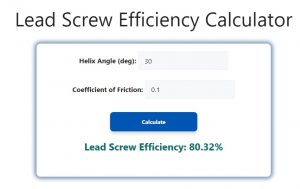About Lead Screw Efficiency Calculator (Formula)
The Lead Screw Efficiency Calculator is a crucial tool for engineers and designers who work with mechanical systems that utilize lead screws. Lead screws are widely used in various applications, from simple linear actuators to complex CNC machinery, due to their ability to convert rotational motion into linear motion. Understanding the efficiency of a lead screw is vital for optimizing performance, reducing energy consumption, and ensuring the longevity of machinery. In this article, we will explain how to use the calculator, provide a practical example, and address frequently asked questions regarding lead screw efficiency.
Formula
The formula to calculate lead screw efficiency is:
Elead = (tan(ha) / (tan(ha + arctan(f)))) * 100
Where:
- Elead is the lead screw efficiency expressed as a percentage.
- ha is the angle of the lead screw thread.
- f is the friction factor, which represents the resistance encountered during motion.
How to Use
- Gather Required Data: To use the Lead Screw Efficiency Calculator, you will need:
- The angle of the lead screw thread (ha) in degrees or radians.
- The friction factor (f) for the specific lead screw material and application.
- Input Values into the Formula: Substitute the angle and friction factor into the formula provided above.
- Calculate Lead Screw Efficiency: Perform the calculation to find the efficiency of the lead screw as a percentage.
- Interpret the Results: Use the calculated efficiency to evaluate the performance of your lead screw and make necessary adjustments to enhance its functionality.
Example
Let’s consider an example to illustrate the calculation of lead screw efficiency.
- Given Data:
- Angle of lead screw thread (ha) = 30 degrees
- Friction factor (f) = 0.1
Step 1: Convert Degrees to Radians
Since the formula requires the angle in radians, convert 30 degrees to radians:
ha (in radians) = 30 * (π / 180) = π/6 radians
Step 2: Calculate arctan(f)
arctan(0.1) = 0.0997 radians (approximately)
Step 3: Calculate tan(ha)
tan(ha) = tan(π/6) = 0.5774
Step 4: Calculate tan(ha + arctan(f))
tan(ha + arctan(0.1)) = tan(π/6 + 0.0997) ≈ 0.6682
Step 5: Calculate Elead
Elead = (0.5774 / 0.6682) * 100 ≈ 86.4%
In this example, the lead screw efficiency is approximately 86.4%, indicating a relatively efficient conversion of input motion to output motion.

FAQs
- What is lead screw efficiency?
Lead screw efficiency measures how effectively a lead screw converts rotational motion into linear motion, considering friction and design. - Why is lead screw efficiency important?
Efficiency affects the overall performance of machines, energy consumption, and the lifespan of the lead screw and associated components. - What factors influence lead screw efficiency?
Factors include the lead screw’s design, material properties, thread angle, and friction between the lead screw and nut. - What is the typical range of lead screw efficiency?
Lead screw efficiency typically ranges from 30% to 90%, depending on the design and application. - How can I improve lead screw efficiency?
Use low-friction materials, optimize the thread angle, and reduce the load on the lead screw to improve efficiency. - What materials are best for lead screws?
Common materials include stainless steel, bronze, and plastics, each offering different friction and wear characteristics. - Is there a difference between lead screw and ball screw efficiency?
Yes, ball screws generally have higher efficiency than lead screws due to reduced friction between the rolling elements. - How do I determine the friction factor for my lead screw?
The friction factor can be obtained from material data sheets or experimental measurements under specific loading conditions. - What role does the angle of the lead screw thread play?
The angle affects the mechanical advantage and the amount of friction encountered during operation. - Can I use this calculator for any type of lead screw?
Yes, as long as you have the necessary parameters (angle and friction factor), the calculator can be applied to various lead screw designs. - How does load affect lead screw efficiency?
Higher loads can increase friction, potentially reducing efficiency, especially in lead screws with lower load ratings. - Is lubrication important for lead screws?
Yes, proper lubrication reduces friction, enhances efficiency, and prolongs the life of the lead screw and nut. - How often should I maintain my lead screw?
Regular maintenance, including cleaning and lubrication, should be performed based on usage frequency and application conditions. - What is the difference between efficiency and effectiveness in lead screws?
Efficiency refers to energy conversion rates, while effectiveness measures how well the lead screw meets the required performance standards. - Can temperature affect lead screw efficiency?
Yes, temperature can alter material properties and lubrication performance, impacting overall efficiency. - Are there industry standards for lead screw performance?
Yes, various industry standards govern lead screw design and performance, ensuring consistency and reliability. - How do I measure the performance of my lead screw?
Performance can be measured through experimental testing of load capacity, speed, and efficiency under various conditions. - What is a typical lead screw pitch?
Lead screw pitches vary widely; common pitches range from 1 mm to 10 mm, depending on the application requirements. - Can lead screw efficiency be calculated for non-linear applications?
The efficiency calculation is primarily for linear applications, but similar principles can apply to non-linear scenarios with appropriate adjustments. - Where can I find additional resources on lead screw design and efficiency?
Resources can be found in engineering textbooks, online courses, and technical papers related to mechanical design and automation.
Conclusion
The Lead Screw Efficiency Calculator provides a straightforward method to assess the efficiency of lead screws, aiding engineers and designers in optimizing their mechanical systems. By understanding the parameters that affect efficiency, users can make informed decisions to enhance performance, reduce energy consumption, and prolong equipment lifespan. Utilizing this calculator, along with the insights shared in this article, empowers users to achieve greater reliability and efficiency in their applications involving lead screws.
